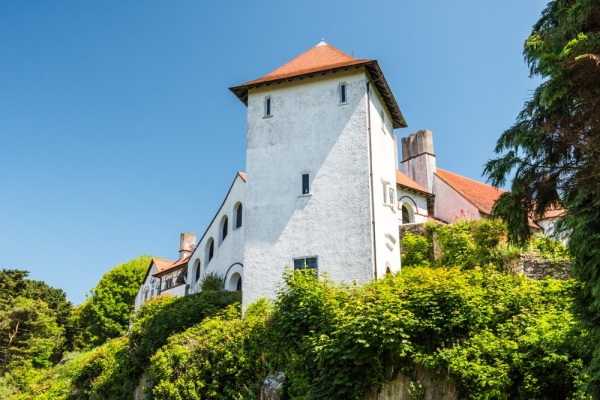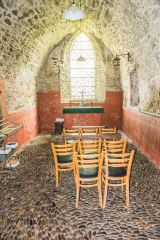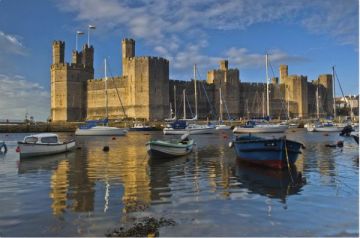
A small island off the Pembrokeshire coast is not the place you would expect to find three historic churches, a ruined medieval priory, a Tudor dovecote, a Catholic monastery, and, perhaps most unusual of all, a chocolate factory. But Caldey Island is no ordinary place.
The island is just 1.5 miles long, with one village and about 500 acres of arable land where crops are grown for export. Caldey is home to 40 permanent residents and about 18 Cistercian monks who occupy Caldey Abbey.
The island has been a religious retreat for over 1500 years, since the first monastery was established here by the 6th-century monk, St Pyro. Every year Caldey welcomes over 3,000 visitors who come to experience the peaceful location, the historic sites, and to sample the handmade perfume, shortbread, and chocolate.
The fact that visitors can only make the boat crossing from Tenby, on the Welsh mainland, when the seas are calm means that the island remains blissfully free of tourists for most of the year, and those that do make the crossing are rewarded by one of the most unique and special places in Wales.

Caldey Priory
The story of Caldey Island really begins with St Pyro, an early Christian monk and a follower of St Illtud, or Illtyd. Pyro founded a monastic community on this tiny island. Caldey's welsh name, 'Ynys Pyr', is thought to come from Pyro's name. However holy Pyro may have been, he had very human failings. He was overfond of drink, and one dark night he drank too much wine and while staggering back to his cell he fell in the monastery well and was killed.
The island site proved easy prey for Viking raiders, and the monks were driven away. They would return in the 12th century when the Normand conquered southern Wales. One of the new Norman lords of Wales was Robert Fitzmartin, who gave Caldey to his mother Geva. Around the year 1131 Geva founded a new monastery of monks following the Tironian rule, as a daughter house of St Dogmael's Abbey near Cardigan. The new Caldey Priory was a poor place, able to support only a few monks. Indeed, when Henry VIII's commissioners came to dissolve the Priory they found only one monk in residence.
The Priory's isolation and lack of funds had a positive result, however, for the medieval monastic layout has remained remarkably unaltered. Parts of the Priory may follow the original monastery layout established by Pyro in the 6th century.

St Illtud's Church
Rising over the Priory ruins is the spire of St Illtud's Church, built in the 13th century and possessing an absurdly crooked spire than leans at a marked angle due to subsidence. The sanctuary floor is made of pebbles gathered from the beach, polished smooth by the passage of feet over centuries. Outside the sanctuary is a 6th-century Ogham stone, bearing inscriptions in both Latin and the ancient Ogham script.
The Caldey Ogham stone was discovered buried in the Priory grounds in the 19th century and was used for a time as a garden seat before being placed for safekeeping inside the church. The Ogham inscription commemorates a servant of Dubricius, which may refer to St Pyro, who was himself a follower of St Dubricius. The Latin text is later, carved in the 8th century and commemorating a man named Catuocunus.
St Illtud's Church is still consecrated and may be the oldest church in Britain still used for Catholic services.
More about St Illtud's Church >>

The Chocolate Factory
A few steps from the door of St Illtud's Church is the Chocolate Factory, one of several ventures launched by the islanders to create an income from visitors to Caldey. The 'factory' occupies some of the historic Priory outbuildings, and the delicious output can be purchased directly from the Factory or at the main island gift shop near the Abbey. To walk into the Chocolate Factory is an experience worth savouring; the smell of chocolate is simply ambrosial!

Caldey Lighthouse
A short walk uphill from the Chocolate Factory and Priory ruins brings you to Caldey Lighthouse, a picturesque whitewashed lighthouse built in 1829 to guide ships safely past St Gowan Shoals and the Helwick Sands. Most of the coastal traffic carried coal or limestone to north and mid Wales, but the lighthouse also helped North American vessels distinguish the Bristol Channel from the English Channel as the arrived from the west.
The lighthouse was designed by Joseph Nelson and cost 4,460 pounds to build. In 1927 Trinity House converted the lighthouse to automatic operation.
The lights ran on acetylene gas, and Caldey Island Lighthouse was the last Trinity House lighthouse to be converted from gas to mains electricity in 1997. The lighthouse stands 16m high and at its base are two dwellings formerly used by the lighthouse keepers and their families. The cottages were added in 1870 and were designed by TC Harvey.
There is no admission to the lighthouse itself but there are several picnic tables by the cliffs and the view is simply stunning.

Island Walks
From the lighthouse you can take a circular walk that leads along the clifftop towards the western tip of the island. There are several places where you can shorten the walk, but if you have the time it is well worth carrying on to almost the western tip of Caldey where the views to the mainland are fabulous. The walks are well signposted and easy to follow, though good walking shoes are a definite plus.

St David's Church
While St Illtud's Church was built to serve the 12th-century monastery, St David's Church was built to serve the island's lay population. The church stands on the site of a 6th-century chapel, which itself was built on the site of a pre-Christian burial ground established as early as the 1st century AD.
When the Norman priory was established in the 12th century the monks used stone from the 6th-century chapel to build the present church nave. The foundations also date from the 6th century. After the priory was suppressed by Henry VIII the church was allowed to decay, and for a time it served as the local smithy. The church was restored by the Benedictine monks of Caldey Abbey in the early 20th century, with vividly coloured windows. The most striking window depicts the Biblical Tree of Life.
St David's is known for the simple wooden crosses used to mark graves of monks and islanders alike.
More about St David's Church >>

Caldey Abbey
When Henry VIII suppressed monasteries in England and Wales during the late 1530s most closed their doors, and the monks left, never to return. Not so with Caldey, though the return took over 470 years.
In 1906 a new Benedictine abbey was founded on the site of the medieval priory, with monastic buildings designed by John Coates-Carver of Penarth. Coates-Carver created an extraordinary set of monastic buildings in Italianate style, which certainly stand out in a very Welsh island setting!
The Benedictine community converted to Roman Catholic practice in 1913, but that was not the end of the story. Financial problems forced the Benedictines to sell the island site in 1925. The community moved to Prinknash Abbey in Gloucestershire, where they still thrive. In their place came Cistercian monks from Scourmont Abbey in Belgium, who occupied Caldey Abbey in 1929.
The abbey managed to survive this time, in part because the monks developed several money-making sideline businesses, producing hand-made perfume, cheese, shortbread, and chocolate. Though there is no regular visitor admission to the abbey buildings, the Abbey does welcome visitors for spiritual retreats.

Caldey Abbey Church
Though visitors are not usually permitted to enter the Abbey itself, they are invited to visit the Abbey church. The church was the first part of the 20th-century abbey to be built and boasts a large rose window under the west gable. The church interior had to be completely restored after a fire in 1940. You can't enter the body of the church, but you can climb to the west gallery, which offers wonderful views over the nave below.

Near the Abbey church is a statue of St Samson, the island's patron saint.
Outside the island's combination shop and post office is a post box, painted in distinctive blue colour, with a sign reading 'No standard times of collection. Collections are made to connect with sailing of boat to Tenby'.
The Watchtower
Often overlooked by visitors to Caldey Island is the Watchtower, now acting as the Chapel of Our Lady Queen of Peace. The Watchtower is a cylindrical building beneath a conical roof. It was probably used as a coastal lookout station, as was a similar tower at Penally, on the mainland.
It dates to at least the 15th century, with one historian suggesting a Norman date of construction based on the very thick walls. It was probably used as a lookout tower. There is a basement, which is not accessible, and a first-floor chamber reached by external stairs. Within the small chamber is a cupboard with wrought-iron hinges, and a large triangular window offers views over the beach below.
The Watchtower is reached by way of a curving path that takes you past Calvary, a huge cross with a figure of Christ crucified.

Getting There
There is only one way for casual visitors to reach Caldey Island and that is by taking the regular boat service from Tenby harbour. The boats operate on a seasonal basis - usually from Easter to October. You can buy a return ticket from the Caldey Island kiosk at the harbour, and boats sail every 20 minutes. The exact departure point varies depending on the tide.
Please note that the boats cannot operate in rough seas. The boat service has a phone number with a recording updated every morning to let callers know if the boats will be sailing that day. I highly recommend calling the number on the morning of your planned trip to avoid showing up the harbour only to discover that there are no crossings that day.
I speak from sad experience; I planned a visit and did not think to call ahead. I showed up at Tenby harbour only to see a sign on the ticket kiosk that all boat trips were cancelled that day due to rough seas. Lesson learned; I called ahead next time! It would be wise to have a 'Plan B' for a day when you want to visit Caldey Island just in case there are no crossings that day.

About Caldey Island
Address: Caldey Island,
Pembrokeshire,
Wales
Attraction Type: Village - Island
Location: Seasonal access only by boat from Tenby harbour. Crossings are weather-dependant.
Website: Caldey Island
Location map
OS: SS141965
Photo Credit: David Ross and Britain Express
NEARBY HISTORIC ATTRACTIONS
Heritage Rated from 1- 5 (low to exceptional) on historic interest
Caldey Island, St David's Church - 0.1 miles (Historic Church) ![]()
Caldey Island Priory - 0.1 miles (Abbey) ![]()
Caldey Island, St Illtud's Church - 0.2 miles (Historic Church) ![]()
Penally, St Nicholas & St Teilo Church - 2.2 miles (Historic Church) ![]()
Tudor Merchant's House - 2.4 miles (Historic House) ![]()
Tenby Museum & Art Gallery - 2.4 miles (Museum) ![]()
Tenby Medieval Town Walls - 2.5 miles (Historic Building) ![]()
Tenby, St Mary's Church - 2.5 miles (Historic Church) ![]()












